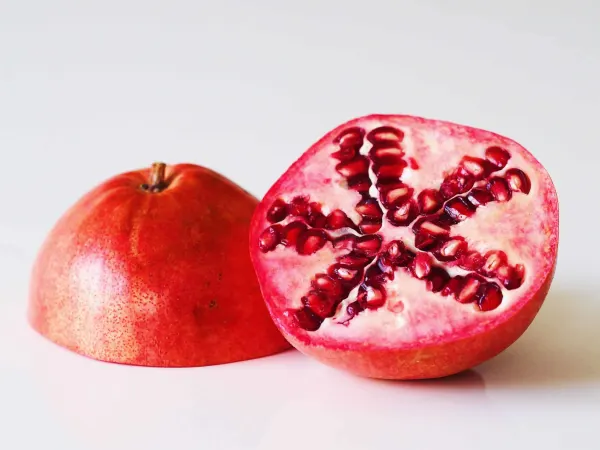Pomegranate
Fruit
Age Suggestion
6 months
Iron-Rich
No
Common Allergen
No

When can babies eat pomegranate?
Pomegranate arils may be introduced as early as 6 months if flattened to reduce the choking risk. Check out our age-specific suggestions. Note that acidic foods like pomegranate seeds can cause or worsen diaper rash.
Background and origins of pomegranate
Pomegranates grow on beautiful, flowering trees and shrubs that are native to Southwest Asia. It is said that the finest pomegranates grow in Iran, where the fruit is a beloved snack and widely used to make juice, salsas, and syrups that are used in savory chicken, eggplant, and fish dishes. The fruit is also a terrific way to introduce tart, tannic flavors to your baby. Just be mindful of clothes and surroundings: while that gorgeous ruby color is sure to delight, it’s also guaranteed to stain whatever it touches!
Videos
Is pomegranate healthy for babies?
Yes! Pomegranate seeds are packed with goodness to support your baby’s development. They’ve got fiber; vitamins B, C, and K; zinc; and more than 150 antioxidants!
We recommend waiting to serve juice of any kind until age 2 to help avoid a preference for sweet drinks, so if you’re going to serve pomegranate juice, offer it as an occasional treat. The juice offers lots of beta-carotene, which our body converts to vitamin A to promote healthy eyes, immune system, and skin. But like all fruit juice, the pomegranate’s naturally occurring sugar gets super concentrated when the liquid is extracted from the seeds. Plus whenever a fruit is juiced, there is a loss of some of the beneficial effects of fiber and other plant compounds that help diversify our microbiome.
Is pomegranate a common choking hazard for babies?
Yes. Pomegranate seeds, because they are round and hard, are a choking hazard for babies under 12 months of age. Don’t be fooled by their small size: just like corn kernels, whole pomegranate seeds can be easily swallowed by accident. To reduce the risk, flatten each seed with the back of a fork before serving, or wait to serve pomegranate seeds until your baby can pick up small pieces of food and chew and swallow with ease.
For more information, visit our section on gagging and choking and familiarize yourself with common choking hazards.
Is pomegranate a common allergen?
No. Pomegranate allergy is rare, though there have been some cases reported. Note, however, that individuals with Oral Allergy Syndrome may be sensitive to pomegranate.
Acidic fruits can also cause a rash wherever the skin comes into contact with it (typically this shows around the mouth, cheeks, and under the chin during the meal). If this happens, just pat the affected area with a cold washcloth (don’t rub) and it should dissipate after a few minutes.
As you would when introducing any new food, start by offering a small quantity on its own for the first couple of servings. If there is no adverse reaction, gradually increase the quantity over future mealtimes.
How do you prepare pomegranate for babies with baby-led weaning?
Every baby develops on their own timeline, and the suggestions on how to cut or prepare particular foods are generalizations for a broad audience.
6 to 12 months old:
Crush or flatten pomegranate seeds with the back of a spoon. Whole pomegranate seeds can be a choking hazard for babies up to age 12 months old.
12 to 18 months old:
At this age your can serve whole pomegranate seeds on their own. Be careful when adding whole seeds to other dishes, as your baby or toddler may not understand the need to chew pomegranate seeds when they’re added to smooth foods like yogurt, and as a result, they may accidentally swallow whole seeds. Bottom line: it’s safer to serve whole seeds on their own until your little one is accustomed to chewing and processing them.
18 to 24 months old:
Time to play! Serve pomegranate seeds on their own, incorporate them into savory dishes for added bite and tartness, and mix them to smoothies.
Want to remove pomegranate seeds from their rind without a big mess? Cut the fruit on the equator and hold one half cut-side down in your palm over a bowl in the sink. Holding a sturdy spoon in your other hand, gently tap the rind, rotating the half in your palm as you tap. The seeds will fall out of the rind and into the bowl in the skin. Wear an apron—juice may spritz on your torso as you tap!
For more information on how to cut food for babies, visit our page on Food Sizes & Shapes.
Written by
Expert Tips Delivered to Your Inbox
Sign up for weekly tips, recipes and more!
The content offered on SolidStarts.com is for informational purposes only. Solidstarts is not engaged in rendering professional advice, whether medical or otherwise, to individual users or their children or families. No content on this site, regardless of date, should ever be used as a substitute for direct medical advice from your doctor or your medical or health professional, nutritionist, or expert in pediatric feeding and eating. By accessing the content on SolidStarts.com, you acknowledge and agree that you are accepting the responsibility for your child’s health and well-being. In return for providing you with an array of content “baby-led weaning” information, you waive any claims that you or your child may have as a result of utilizing the content on SolidStarts.com.



